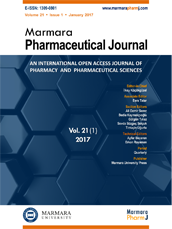Editor-in-Chief
Hatice Kübra Elçioğlu
Vice Editors
Levent Kabasakal
Esra Tatar
Online ISSN
2630-6344
Publisher
Marmara University
Frequency
Bimonthly (Six issues / year)
Abbreviation
J.Res.Pharm.
Former Name
Marmara Pharmaceutical Journal
Marmara Pharmaceutical Journal
2018 , Vol 22 , Issue 1
evaluation of taste, total phenols and antioxidant for fresh, roasted, shade dried and boiled leaves of edible Arum palaestinum Bioss
1Department of Biomedical Sciences, Faculty of Medicine and Health Sciences, An-Najah National University, Nablus, Palestine2Department of Pharmacy, Faculty of Medicine and Health Sciences, An-Najah National University, Nablus, Palestine
3Department of Agricultural and Biological Engineering, Faculty of Engineering, Palestine Technical University, Kadoorie, Palestine
4Department of Computer Information Systems, Faculty of Engineering and Information Technology, An-Najah National University, Nablus, Palestine DOI : 10.12991/mpj.2018.40 Arum palaestinum is one of the famous wild plants that have been used since the ancient time in the Palestinian folk food and medicine. However, it needs particular cooking steps to decrease its numbing taste. We investigated the impact of cooking, measures on taste, total phenols and antioxidant activity of wild A. palaestinum by using an Alpha-Astree Electronic tongue (ET), which is used for food taste assessment. In this study, the A. palaestinum was cooked in different ways. We used Folin Ciocalteu"s process to compare total phenols, where radical scavenging assay was used to evaluate the antioxidant activity using 2, 2-diphenyl- 1-picrylhydrazyl-hydrate (DPPH). Our results showed that a very significant discrimination of the samples with different distances between groups (p-values < 0.001) in the ET results coupled with the principal component analysis (PCA). The samples were in the following order in term of numbing taste: Fresh > dried > cooked. Moreover, the pattern discrimination index between (A and C), (B and C) and (A and B) were 88%, 96.36%, and 98%, respectively, which suggests that C and A are the most similar preparations in term of taste, while B is the worst one. Our results reveal that the cooking and dried A. palaestinum showed a lower numbing taste by ET, while the antioxidant activities showed a marked correlation with the total phenolic contents. As a result, we concluded that the oven dried preparing method (home roasting) for A. palaestinum is the most efficient method for consumption or preparing bioactive supplements for nutraceutical and pharmaceutical supplements. Keywords : Arum palaestinum; antioxidants; total phenolic content; edible wild plants

